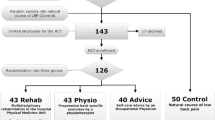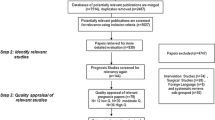Abstract
Objective: To assess, from the review literature, the extent to which effective strategies for reducing work absence after acute low back pain (LBP) match empirical risk factors. Methods: From 17 recent review articles (2000–2005), disability risk factors and interventions were cross-tabulated to assess levels of relative concordance. Results: Potentially modifiable risk factors included 23 variables describing 3 workplace and 3 personal domains. Effective interventions included 25 strategies that were personal (physical or behavioral), engineering, or administrative in nature. There was a strong risk factor concordance for workplace technical and organizational interventions, graded activity exposure, and cognitive restructuring of pain beliefs. There was less risk factor concordance for exercise, back education, and RTW coordination. Few interventions focused on relieving emotional distress or improving job dissatisfaction, two well-supported risk factors. Discussion: Gaps between the epidemiological and intervention research of back disability prevention could be reduced by testing mediators of intervention effects or by stratifying outcomes according to pre-intervention risk factors.

Similar content being viewed by others
References
Nachemson A, Waddell G, Norlund AI. Epidemiology of neck and low back pain. In: Nachemson A, Jonsson E editors, Neck and back pain: The scientific evidence of causes, diagnosis, and treatment. Philadelphia: Lippincott Williams & Wilkins, 2000, p. 165–87.
Waddell G, Aylward M, Sawney P. Back pain, incapacitiy for work and social security benefits: An international literature review and analysis. London: The Royal Society of Medicine Press 2002.
Crombie IK, Davies JTP. Requirements for epidemiological studies. In: Crombie IK, Croft PF, Linton SJ, LeResche L, Von Korff M editors, Epidemiology of pain. Seattle: IASP Press; 1999, p. 17–24.
Guo HR, Tanaka S, Cameron LL. Back pain among workers in the United States: National estimates and workers at high risk. Am J Ind Med 1995; 28:591–602.
Feldman JB. The prevention of occupational low back pain disability: evidence-based reviews point in a new direction. J Surg Orthop Adv 2004;13:1–14.
Franche RL, Baril R, Shaw WS, Nicholas M, Loisel P. Workplace-based return-to-work interventions: Optimizing the role of stakeholders in implementation and research. J Occup Rehabil 2005;15:525–42.
Loisel P, Buchbinder R, Hazard R, Keller R, Scheel I, van Tulder M, Webster B. Prevention of work disability due to musculoskeletal disorders: The challenge of implementing evidence. J Occup Rehabil 2005;15:507–24.
Pransky G, Gatchel R, Linton SJ, Loisel P. Improving return to work research. J Occup Rehabil 2005;15:453–7.
Schultz IZ, Crook JM, Berkowitz J, Meloche GR, Milner R, Zuberbier OA, Meloche W. Biopsychosocial multivariate predictive model of occupational low back disability. Spine 2002;27:2720–5.
Main CJ. Concepts of treatment and prevention in musculoskeletal disorders. In: Linton SJ editor, New avenues for the prevention of chronic musculoskeletal pain and disability. Boston: Elsevier; 2002, p. 47–63.
Hayden J, Cote P. Methodological considerations to limit bias in low back pain prognosis studies: An international expert consensus. Workshop held at the Amsterdam International Forum VIII on Primary Care Research on Low Back Pain, Amsterdam, The Netherlands, June 2006.
MacFarlane GJ, Jones GT, Hannaford PC. Managing low back pain presenting to primary care: where do we go from here? Pain 2006;122:219–22.
Waddell G. The Back Pain Revolution, 2nd edition. New York: Churchill-Livingstone, 2004, p. 265–82
Crook J, Milner R, Schultz IZ, Stringer B. Determinants of occupational disability following a back injury: A critical review of the literature. J Occup Rehabil 2002;12:277–95.
Hashemi L, Webster BS, Clancy EA, Volinn E. Length of disability and cost of workers' compensation low back pain claims. J Occup Environ Med 1997;39:937–45.
Baril R, Clarke J, Friesen M, Stock S, Cole D, Work-ready group. Management of return-to-work programs for workers with musculoskeletal disorders: a qualitative study in three Canadian provinces. Soc Sci Med 2003;57:2101–14.
Nicholas MK. Reducing disability in injured workers: The importance of collaborative management. In Linton SJ editor New avenues for the prevention of chronic musculoskeletal pain and disability. Amsterdam: Elsevier, 2002, p. 33–46.
Shaw WS, Robertson MM, Pransky G, McLellan RK. Training to optimize the response of supervisors to work injuires—needs assessment, design, and evaluation. AAOHN J 2006;54:226–35.
Derebery VJ, Giang GM, Saracino G, Fogarty WT. Evaluation of the impact of a low back pain educational intervention on physicians' practice patterns and patients' outcomes. J Occup Environ Med 2002;44:977–84.
Loisel P, Durand MJ, Baril R, Gervais J, Falardeau M. Interorganizational collaboration in occupational rehabilitation: perceptions of an interdisciplinary rehabilitation team. J Occup Rehabil 2005;15:581–90.
Gatchel RJ, Polatin PB, Noe C, Gardea M, Pulliam C, Thompson J. Treatment and cost-effectiveness of early intervention for acute low-back pain patients: A one-year prospective study. J Occup Rehabil 2003;13:1–9.
Linton SJ, Nordin E. A 5-year follow-up evaluation of the health and economic consequences of an early cognitive behavioral intervention for back pain: A randomized, controlled trial. Spine 2006;31:853-8.
Von Korff M, Balderson BHK, Saunders K, Miglioretti DL, Lin EHB, Berry S, Moore JE, Turner JE. A trial of an activating intervention for chronic back pain in primary care and physical therapy settings. Pain 2005;113:323–30.
Gervais S, Dupuis G, Veronneau F, Bergeron Y, Millette D, Avard J. Predictive model to determine cost/benefit of early detection and intervention in occupational low back pain. J Occup Rehabil 1991;1:113–31.
Dionne CE, Bourbonnais R, Fremont P, Rossignol M, Stock SR, Larocque I. A clinical return-to-work rule for patients with back pain. CMAJ 2005;172:1559–67.
Loisel P, Vachon B, Lemaire J, Durand MJ, Poitras S, Stock S, Tremblay C. Discriminative and predictive validity assessment of the Quebec task force classification. Spine 2002;27:851–28.
Hartvigsen J, Lings S, Leboeuf-Yde C, Bakketeig L. Psychosocial factors at work in relation to low back pain and consequences of low back pain; a systematic, critical review of prospective cohort studies. Occup Environ Med 2004;61:e2.
Hoogendoorn WE, van Poppel MN, Bongers PM, Koes BW, Bouter LM. Systematic review of psychosocial factors at work and private life as risk factors for back pain. Spine 2000;25:2114–25.
Linton SJ. Occupational psychological factors increase the risk for back pain: A systematic review. J Occup Rehabil 2001;11:53–66.
Linton SJ. Psychological risk factors for neck and back pain. In: Nachemson A, Jonsson E editor, Neck and back pain: The Scientific Evidence of Causes, Diagnosis, and Treatment. Philadephia: Lippincott Williams & Wilkins, 2000, p. 57–78.
Pincus T, Burton AK, Vogel S, Field AP. A systematic review of psychological factors as predictors of chronicity/disability in prospective cohorts of low back pain. Spine 2002;27:E109–20.
Shaw WS, Pransky G, Fitzgerald TE. Early prognosis for low back disability: Intervention strategies for health care providers. Disabil Rehabil 2001;23:815–28.
Steenstra IA, Verbeek JH, Heymans MW, Bongers PM. Prognostic factors for duration of sick leave in patients sick listed with acute low back pain: A systematic review of the literature. Occup Environ Med 2005;62:851–60.
Linton SJ, Gross D, Schultz IZ, Main C, Cote P, Pransky G, Johnson W. Prognosis and identification of workers risking disability: Research issues and directions for future research. J Occup Rehabil 2005;15:459–74.
Pransky G, Shaw W, Fitzgerald TE. Prognosis in acute occupational low back pain: Methodologic and practical considerations. Human Ecolog Risk Assess 2001;7:1811–25.
Turk DC, Okifuji A. Evaluating the role of physical, operant, cognitive, and affective factors in the pain behaviors of chronic pain patients. Behav Modif 1997;21:259–80.
Loisel P, Durand M-J, Berthelette D, Vezina N, Baril R, Gagnon D, Lariviere C, Tremblay C. Disability prevention: New paradigm for the management of occupational back pain. Dis Manage Health Outcomes 2001;9:351–60.
Franche RL, Cullen K, Clarke J, Irvin E, Sinclair S, Frank J. Workplace-based return-to-work interventions: A systematic review of the quantitative literature. J Occup Rehabil 2005;15:607–31.
Linton SJ. Utility of cognitive-behavioral psychological treatments. In: Nachemson A, Jonsson E editor, Neck and back pain: the scientific evidence of causes, diagnosis, and treatment. Philadelphia, PA: Lippincott Williams & Wilkins, 2000, p. 361–81.
Ostelo RWJG, van Tulder MW, Vlaeyen JWS, Linton SJ, Morley SJ, Assendelft WJJ. Behavioral treatment for chronic low back pain. The Cochrane Database of Systematic Reviews 2005, Issue 1. Art. No.:CD002014.pub2, 2005.
Rainville J, Hartigan C, Martinez E, Limke J, Jouve C, Finno M. Exercise as a treatment for chronic LBP. Spine J 2004;4:106–15.
Schonstein E, Kenny D, Keating J, Koes B, Herbert RD. Physical conditioning programs for workers with back and neck pain: a cochrane systematic review. Spine 2003;28:E391–5.
Shaw WS, Feuerstein M, Huang GD. Secondary prevention and the workplace. In: Linton SJ, ed. New Avenues for the Prevention of Chronic Musculoskeletal Pain and Disability. London: Elsevier, 2002, p. 215–35.
Snook SH. Work-related low back pain: Secondary intervention. J Electromyogr Kinesiol 2004;14:153–60.
Staal JB, Hlobil H, van Tulder MW, Koke AJ, Smid T, van Mechelen W. Return-to-work interventions for low back pain: A descriptive review of contents and concepts of working mechanisms. Sports Med 2002;32:251–67.
Sullivan MJL, Feuerstein M, Gatchel RJ, Linton SJ, Pransky G. Integrating psychosocial and behavioral interventions to achieve optimal rehabilitation outcomes. J Occup Rehabil 2005;15:475–89.
Elders LAM, Van Der Beek AJ, Burdorf A. Return to work after sickness absence due to back disorders—a systematic review on intervention strategies. Int Arch Occup Environ Health 2000;73:339–48.
Zwerling C, Daltroy LH, Fine LJ, Johnston JJ, Melius J, Silverstein BA. Design and conduct of occupational intervention studies: a review of evaluation strategies. Am J Ind Med 1997;32:164–79.
National Reseach Council, Institute of Medicine. Musculoskeletal disorders and the workplace: Low back and upper extremities. Washington, DC: National Academy Press, 2001, p. 85–301.
Shaw WS, Robertson MM, McLellan RK, Verma SK, Pransky G. A controlled case study of supervisor training to optimize response to injury in the food processing industry. Work 2006;26:107–14.
Staal JB, Hlobil H, Twisk JW, Smid T, Koke AJ, van Mechelen W. Graded activity for low back pain in occupational health care: a randomized, controlled trial. Ann Intern Med 2004;140:77–84.
Sullivan MJ, Stanish WD. Psychologically based occupational rehabilitation: the Pain-Disability Prevention Program. Clin J Pain 2003;19:97–104.
Young AE, Wasiak R, Roessler RT, McPherson KM, Anema JR, van Poppel MNM. Return-to-work outcomes following work disability: Stakeholder motivations, interests, and concerns. J Occup Rehabil 2005;15:543–56.
Boersma K, Linton SJ. Psychological processes underlying the development of a chronic pain problem: a prospective study of the relationship between profiles of psychological variables in the fear-avoidance model and disability. Clin J Pain 2006;22:160–6.
Shaw WS, Pransky G, Patterson W, Linton SJ, Winters T. Patient clusters in acute low back pain based on disability risk factors. J Occup Environ Med (under review).
Webster BS, Courtney TK, Huang YH, Matz S, Christiani DC. Physicians' initial management of acute low back pain versus evidence-based guidelines. Influence of sciatica. J Gen Intern Med 2005;20:1132–5.
Webster BS, Courtney TK, Huang YH, Matz S, Christiani DC. Survey of acute low back pain management by specialty group and practice experience. J Occup Environ Med 2006;48:723–32.
Carroll LJ, Cassidy JD, Cote P. Factors associated with the onset of an episode of depressive symptoms in the general population. J Clin Epidemiol 2003;56:651–8.
Feuerstein M, Harrington CB, Lopez M, Haufler A. How do job stress and ergonomic factors impact clinic visits in acute low back pain? A prospective study. J Occup Environ Med 2006;48:607–14.
Sullivan MJ, Ward LC, Tripp D, French DJ, Adams H, Stanish WD. Secondary prevention of work disability: community-based psychosocial intervention for musculoskeletal disorders. J Occup Rehabil 2005;15:377–92.
George SZ, Fritz JM, McNeil DW. Fear-avoidance beliefs as measured by the fear-avoidance beliefs questionnaire: change in fear-avoidance beliefs questionnaire is predictive of change in self-report of disability and pain intensity for patients with acute low back pain. Clin J Pain 2006;22:197–203.
Acknowledgment
This study was supported by research funding from the Liberty Mutual Group (Project CDR 05-02), Boston, MA and a travel grant from the Scan/Design by Inger and Jens Bruun Foundation.
Author information
Authors and Affiliations
Corresponding author
Rights and permissions
About this article
Cite this article
Shaw, W.S., Linton, S.J. & Pransky, G. Reducing Sickness Absence from Work due to Low Back Pain: How Well do Intervention Strategies Match Modifiable Risk Factors?. J Occup Rehabil 16, 591–605 (2006). https://doi.org/10.1007/s10926-006-9061-0
Published:
Issue Date:
DOI: https://doi.org/10.1007/s10926-006-9061-0




